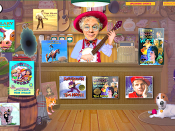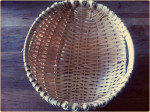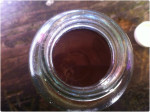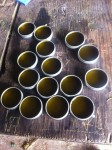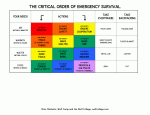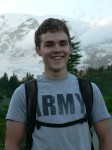THIS POST BY RACHEL EDWARDS, SUMMER TEACHING APPRENTICE…
The first overnight camp of the summer was survival week. The kids came to either be a part of the introduction to survival or to go on the advanced survival trek out on your own away from base camp. To learn these skills is why I came to Wolf Camp, so I was excited to venture out for my first survival trek. I was a bit nervous because I knew nothing about the art of survival but would not be in the introductory group but was going out on the trek without any previously learned skills. Chris thought that this would be how I would learn the most, which makes sense because the learning is in the doing. I had no visual for what a survival trek exactly looked like so I was venturing out into the unknown.
The kids arrived on Sunday afternoon and after a few icebreakers, we soon got started preparing ourselves for what materials we needed to make our trek a success. I felt to be in good hands because of the knowledge and skills that Andrew, our survival trek leader possessed. I knew that I would learn everything I needed to know from him.
When you think about survival, you think of the things that are essential for you to stay alive in any situation. Fire, water, shelter, food… All of these are of importance, but depending on the survival situation you find yourself in will determine which of these is of utmost importance. If you have no water, then finding a water source and making a fire to purify it is of the most importance. If it’s freezing outside and you have no way to stay warm, then fire and shelter are of utmost importance. Usually food falls lower on the importance list since you can go for many days without it. But water, your body can’t function without.
Those of us going on the trek knew that fire would be essential, so the first thing we began making were our fire kits. In the Pacific Northwest, the cedar tree is known as the fire tree. You can make everything you need from this giving tree. We learn these skills from our native ancestors. We look to them to learn the ways of survival. They walked this land without lighters and modern technologies. There are three pieces to a fire kit. A bow drill, a fire board, and a spindle. To construct these things takes many hours and knowing what part of the cedar is best to use. On Monday, I started to make my kit out of cedar branches, but after hours of work, I soon learned that it needs to be made out of the beautifully red heartwood. So on Tuesday, the day we were leaving for the trek, I had to construct another one, which I spent many hours doing.
In between the fire kit making, we made jerky over the fire to provide some food for the trek. We were rationed a small quantity of food. I was given eight pieces of  beef jerky, three packs of nuts, half a potato, one ear of corn, and one cup of flour for making ash cakes. This was all to be rationed so that I was fed Tuesday evening through Friday morning. I was also to take with me a tarp and sleeping bag that would only be used on the first night since there would not be time on Tuesday to complete a shelter. I would also have a knife, one full water bottle, a cup to boil water in, rain gear, and warm clothes.
beef jerky, three packs of nuts, half a potato, one ear of corn, and one cup of flour for making ash cakes. This was all to be rationed so that I was fed Tuesday evening through Friday morning. I was also to take with me a tarp and sleeping bag that would only be used on the first night since there would not be time on Tuesday to complete a shelter. I would also have a knife, one full water bottle, a cup to boil water in, rain gear, and warm clothes.
By the time Tuesday afternoon had come we had still not fully completed our fire kits but felt we could continue working on them at our trek spot. So I ventured out with five others and our leader, Andrew. Of the five others, four were young boys ages fourteen to fifteen and another girl who was fourteen. We hiked out for about an hour until we came to a place that we thought would be good for us all to find our own place to create our camps. This was supposed to be a solo survival trek. When we came to the place where Andrew said he would make his camp, he told us we were all to go out and find our own spots away from each other. Andrew told us we were to do a bear hang…we had seen bear tracks on the way to the spot. At this point I was starting to get concerned on the inside. I had never done a bear hang and didn’t have any idea how to do something like that, especially with a limited amount of rope. Then Andrew said, “Now don’t anyone be coming over here asking me questions, I will make sure to come by and see you each day.” After Andrew said that, I broke down and began to cry. Not a huge cry, just a few tears because I had no idea what I was doing. I had never done a trek like this. I was expected to be taught the ways of survival. The tears didn’t last long because I couldn’t help but laugh at myself for crying.
So I headed off in the direction I was being called and found a place that would be a good spot to make a camp. After looking around I found the best place to hang my tarp. It was getting dark at this point and I was glad to get the tarp up because it had just started to rain when I finished hanging it. Andrew came over to check on me and helped me secure the tarp from collecting water. He also told me that a bear hang wasn’t necessary. I felt much more at peace now and felt secure in my ability to be in the woods. Knowing that others were not that far away aided in my comfort level. I love being with the earth, especially all the nighttime sounds but knowing that others were near by allowed me to fully appreciate all that the nighttime brings. I was not scared about the bears or mountain lions, even though we had seen tracks and I had found bear scat in the middle of my chosen camp. I crawled into my sleeping bag under the tarp and listened to the pitter patter of the rain. I was using my bag as a pillow and before falling asleep decided to remove my food pack from my bag and at least move it beside a tree rather than under my head. We all know that bears have incredible sense of smell. Having the food under my head didn’t seem like the best place for it. Then I drifted off to sleep, feeling the unknown of how the next few days would unfold.
I awoke the next morning to the brisk air, feeling grateful to have slept the whole night through cozy in my sleeping bag. I resisted getting up so spent some time just laying around. The resistance to getting up came from me not knowing what I should be doing to prepare my camp. But I assume it was around ten when I did make it out of my shelter. I looked around my camp and decided that I wanted to be productive even though I wasn’t sure what materials I would need. I new that shelter was going to be very important so I just started making a pile of sticks that could be of use.
It hadn’t been long when Andrew came over. He spent some time with me walking around the area I had chose. He was teaching me about choosing the right spot to build a shelter. You want a dry place where if it rained water wouldn’t puddle. In the Northwest forest, the canopy is so dense that in many places the rain never reaches the ground. These are the places you want to build a shelter. You also have to look around you and make sure that there are no tree snags or other things that could fall on you. We decided that the best place would be under this fallen tree that was wide enough to protect me from the rain and high enough off the ground for me to squeeze under it. When building a debris hut, you want the size to be just enough for you to fit into but no more. Having a small space means you have less air to keep warm and less of a space to pack full of debris. My plan for building the hut was to gather sticks and lay them up against the fallen tree. This part of the shelter is known as the skeleton. Once you have the skeleton built, you want to gather materials to make it waterproof. I decided to gather large pieces of bark from the trees that were decomposing and lay them up against the skeleton. Depending on the circumstances you may want to then pack debris a few feet thick on top of the bark to secure the waterproofing but since the fallen tree was so big, I felt confident that I wouldn’t get wet, especially being so protected by the forest canopy. The building of the shelter took me most of the day.
I then decided to search out a water source. I had only half left of my water bottle. Andrew told me where he found a skunk cabbage swamp with water, but I was hesitant about that. I knew there was a river near by, I preferred to drink from a flowing source, not swampy brown water. I headed towards where I knew the river to be with my metal cup in hand. I followed a trail down and then spotted the river. I couldn’t find a trail to the river so I just bush wacked down the steep bank wondering how I would ever get back up without spilling the water. But I was determined. I sat by the river for a bit feeling the sunshine that was hard to notice in the thick forest. I filled my cup and determined the best way to head back up. It was actually quite a bit of fun to adventure out to find water. I even managed to make it back to camp with only spilling a small amount out of the cup. I was impressed by my skills. Finding the water was the easy part, the hard part was to get a fire going so I could boil it to drink. I had gotten sick before from drinking bad water and never want to experience that again.
I was now onto fire. I gathered rocks and built a nice small fire circle. In my camp there was a fallen hemlock tree that would make great fire starting pencil lead. I gathered pencil lead and other small dry sticks and constructed a really nice fire tipi. This was the easy part. I still had work to do on my fire kit, like getting my notch into my fire board, so I worked on that for a while and was able to successfully get my notch carved out. I just hoped that I had carved it out right since it was my first notch ever. I looked forward to getting some fire assistance from Andrew. The night was closing in and decided to go to bed rather than work on my bow drill in the dark. I was hungry and had eaten only on pack of nuts and a few pieces of beef jerky the whole day and my water bottle was almost empty. I climbed into my shelter with my sleeping bag knowing that many things needed to be done tomorrow.
When the morning came, I waited for the call from Andrew to get a fire lesson. All of the other trekkers had not gotten fire and had ran out of water the day before. I had a few sips left so water was high on my importance list. When I got to Andrew’s camp, only one of the others were there to receive a fire lesson. We just assumed the others were still sleeping so we waited a bit. Come to find out the boys had already been up discussing with each other their intentions to leave. One of the boys had left in the night and the girl had left the day before. Soon it was just me and another trekker, along with Andrew. That didn’t last long because Chris brought three others up from the intro camp to spend a night out in a shelter they were to build. Andrew spent some time with the others who had just arrived teaching them about shelter building while I spent time filling my sleeping bag with dry maple leaf litter to pack into my hut so I could stay warm without a sleeping bag. I filled the bag up three times and packed the shelter with it. I was quite tired this day and was starting to need water pretty bad. Andrew was determined to make sure that I got fire and said that I could work with the other trekker to get a coal on one of our bow drill kits. We spent some time working together but our kits seemed to be needing constant tweaking. So Andrew decided to just try out my kit just to see if he could get a coal and sure enough he did. Part of him wanted to put the coal out but he said the look in our eyes made him unable to do it. I put the coal into my cedar tinder bundle and blew it into flames and placed it into the tipi fire I had built the day before. I was so excited. My cup of water from the river had been sitting in a safe place since yesterday and I was so thirsty, hungry too. I also had half a potato, an ear of corn, and flour to make ash cakes. Soon the other three joined us and we ended up sitting around the fire eating and laughing and having the best night. I was so grateful to have fire, boiled water, food, and awesome company. What a way to end the last night of a so called solo survival trek.
The next morning we returned all of our used materials back to the earth, leaving no trace and headed back to camp for a nice warm breakfast. Before we left, I joined all the trekkers together in a circle and thanked the land and earth mother who provided for us and kept us safe. I felt like I could have stayed out for many more days but was happy to head back to the modern world of endless clean water and food.

